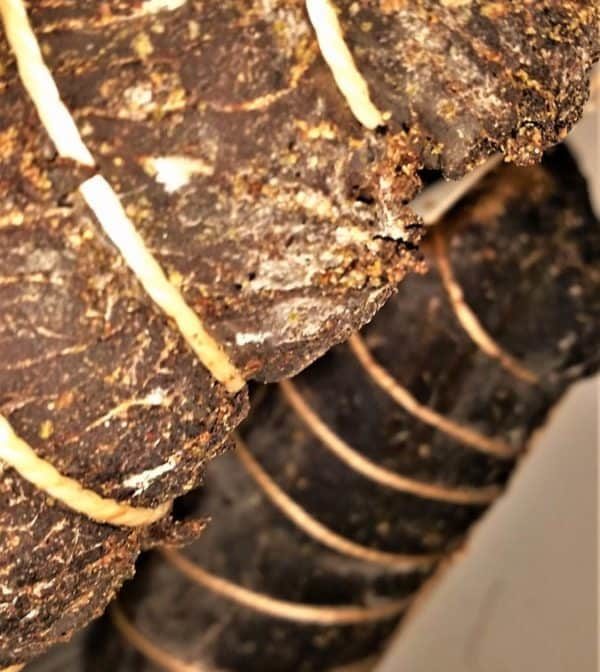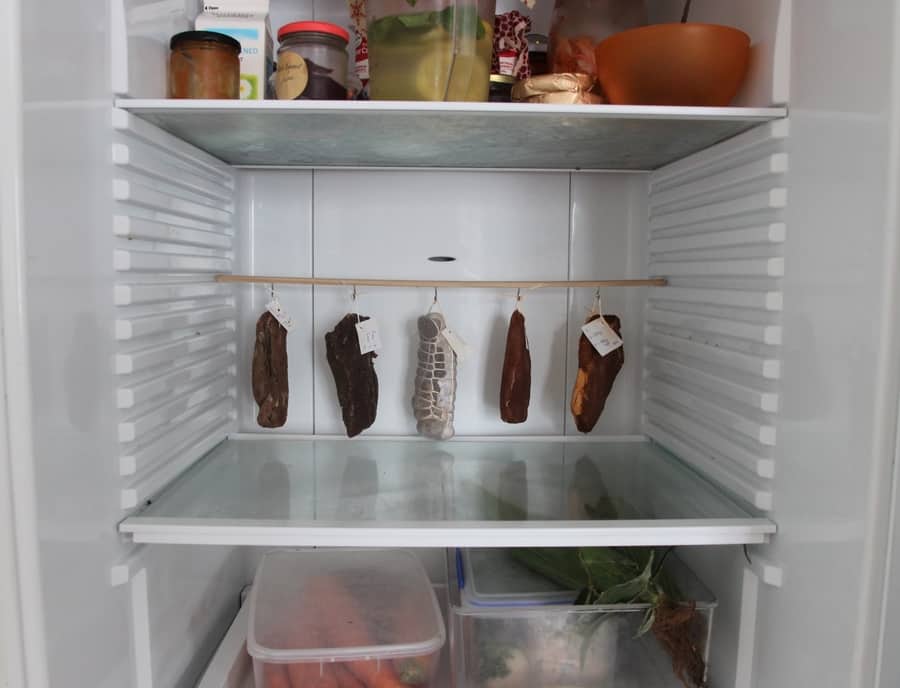When I first started curing wild game meat a few decades ago, I based my ideas on the techniques used for lean, dry curing, and Italian recipes.
The results were fantastic! At the end of the day, meat is meat, and wild meat is generally leaner.
Curing the meat allows a whole other level of appreciation from what you harvest in the wild.
Over the years I have used different types of wild deer, goat, turkey, duck, boar trout, and salmon for cured meat projects.
Curing has a wide definition so I just want to give some ideas of various ways I cure my harvested wild meat.

Dry Cured Wild Venison in my Curing Chamber
How to Cure Wild Game Meat
To cure wild game meat a dry cure salt or wet salt brine is used. Depending on the type of meat and cut being used. How the game meat is cured will depend on what cut and kind of meat are being used. The main methods of curing meat are hot or cold smoking and drying the meat.
Here are the Ways I shall elaborate on, what I’ve done.
Ways of Curing Wild Game Meat
These are the ways I have had great success with:
- Wild Red Game meat, used for dry curing
- Large poultry game for smoking
- Red game meat cuts for jerky or biltong
- Wild Game salt saturation cured for Long Term Preservation
It’s the same as farmed meat which is generally leaner meat. It all depends on what the wild game has been eating. This also means as you know, wild game (here is a link to the wild game article category list on this site) can vary in flavor greatly!
Wild Red Game Meat – Dry-Curing
Dry Curing is using salt to preserve the meat, once 35% weight loss has been obtained, the meat can be consumed. It’s dried meat like jerky or biltong but using Italian craft skills for a more refined product. Here are some smaller chunks from my DIY Curing Chamber.
I have learned a technique called equilibrium curing, you measure the salt content as a percentage of the meat weight. By doing this, you can get precision curing, and choose the salt level.
Cutting thinly this stuff is

When I harvest larger red meat wild game, after splitting up the prime steak cuts, roasting cuts and the curry/casseroles/curry pieces. I have a selection of options.
The hind leg prime muscles offer a lot of options. Once all the sinew is cleaned up (unless you are freezing the muscle, then the sinew can help protect the meat when frozen).
Dry curing that I do, can be done, in a cellar, a normal fridge, or a DIY curing chamber.
When doing it in a normal fridge, you need to slice up the major muscles to about 1/2 pound / 200 grams, so the meat can dry nicely. Since a normal fridge runs at about 30-50% humidity it’s not perfect for dry-curing but it’s close enough for smaller cuts. This is the setup I use:

If you want more info on dry curing in a normal fridge, I wrote a whole guide on it here.
But many years ago when I started getting into curing meats, I found it brought out a whole new appreciation for the process/experience/journey of hunting wild game.
If you want to learn more about Do it Yourself curing chambers, please find a link here.
I use the equilibrium curing method, which is curing by a percentage of salt with to the weight of the meat you are curing. It means you get an accurate saltiness and you can choose how much salt you prefer based on your taste.
Braesola Style Game Meat
The Italians created a delicious dry-cured beef recipe using the eye of round from the cow. This kind of meat is extremely lean and solid meat, which made me think it would be similar to a lot of the wild red meat that I harvest.
So I used this kind of spice blend to do a wild game-style bresaola
- salt
- sugar
- black pepper
- nutmeg
- cinnamon
I have used this style for many different cuts and shapes sometimes chopping up the whole muscle more, especially for quicker
Smoking Large Game Birds – Turkey, Duck, Pigeon
Wild Turkey Brining
Curing with a wet brine, I found it best since it helps retain the moisture in the bird. A wild turkey is something I love to hot smoke. For the younger turkey I find they can be roasted out reasonably well, the turkeys I harvest roam around near maize farms, so they are packed full of corn-fed fat.
For the larger turkeys, I’ll break them down, and take the breasts
- Salt = 5% or 50 grams of sea salt to 1 quart/1 liter of water
- Sugar =2.5% of the meat weight
- White wine – 1 cup
- garlic – 4 cloves
- Bay leaves – 4 leaves
- Thyme – 4 sprigs
- Pepper – tablespoon
It’s harder for the flavors to penetrate using
I generally will use a portable indirect hot smoker because it’s easy and simple to handle for turkey breasts It will be nicely smoked for 20 to 30 minutes at a moderately low temperature under 200°F temperature.
For longer smoking sessions, which helps get more smoke flavor in. Sometimes I will use a kettle grill, doing the indirect heat snake method. If there is more low & slow smoking to be done, I will use the electric smoker.
Red Game Meat – Jerky & Biltong
So I have refined my jerky/biltong recipes which I love to prepare before a big hunting trip. This is a kind of the ultimate hunting snack, I use the South African style biltong the base classic recipe is salt, malt vinegar, and toasted coriander.
I like to add smoked paprika, chili, and sometimes a few juniper berries (a classic pairing with red game meat).
For biltong &
I have done biltong and jerky in the oven or a dehydrator. But once I got my DIY curing chamber I like to slow down the drying process and do it over two or three days.
South Africans like a dry or wet style, which means that you have a little bit of moisture in the meat and it’s not fully dried. This is easier to achieve when you can control the humidity and temperature.
Acidity with vinegar is also used for this style of preserved and cured meat.
I do know a guy who owns a commercial biltong company, and curing and drying the meat in massive drying machines. It takes him about 2-3 days, but he does the South African style.
Jerky’s preservation is mainly based on salt, some do low-temperature cook it also for another safety measure.
Other Cured Meats for Wild Game
Curing Wild Boar & Pig
I have had some success using wild pork for making
Because the boar the wild pig is lean, it’s kind of like a ham I found it never had enough fat to be a ‘bacon’ Unless you can see an obese wild pig, you never know. It’s pretty hard for a pig to get obese living in the wild, just like humans I guess.
Dry Cured Salami
There are generally two types of salami the cooked salami which is what many butchers I have come across do. Then there is dry cured salami, which involves fermenting and then drying the meat with maybe some smoking.
Dry curing salami is an involved process with quite a few steps, which would put this in the advanced meat curing category. Hey, but it’s just a process so you just need the right guidance.
Recently I did a salami which was wild meat blended with venison (here is an article about what I do with venison cuts) and pork fat you have to add the farmed pork fat as well to get the fat content up I have found. My friend and I spent a weekend processing 30kg/66 pounds of meat for one-third sausage and the rest for a few dry-cured salami recipes.
A Kielbasa Eastern European sweet paprika salami and a Spicy Venison salami – used 2% and 3% salt to the weight of the meat. Using a higher percentage for the stronger chili-spiced salami worked out well.
Wild Duck Bierstick or Mini Salami Sticks
Mini salamis can be awesome as a protein snack food if you harvest a lot of meat. I have even come across some butchers that will do the work for you. I prefer to do my own of course.
Curing for Long Term Storage
Salt Fish, Pork, or Salt Beef style.
Salt pork or beef (I wrote about charcuterie that is not pork here) I’ve been reading about recently, were used extensively as rations and in military campaigns around the world wars.
So if you’re looking for long-term preservation of meat this would be the way it was also used before refrigeration was standard across the Western world. The preference though was to your pork belly, so you had a decent level of fat & meat.
I have ‘salt-cured’ venison and wild pork with the same method, using leaner cuts. You can then use the meat later on without freezing it (I just keep it wrapped in the kitchen fridge).
The basic method is to use the saturation (article link to this method) or salt box method and completely take out as much moisture as possible from the meat. This means the bacteria can’t thrive and then you just need to find cool areas to store the meat. If you want some more info on salt pork, I wrote a full post here.
Related Questions
Can you Eat Deer Meat Right After you Kill it?
Yes, but it will be tough. The offal parts of the animal are best suited to immediate consumption. The liver and heart are favorable organs to consume after killing a deer. Major muscle groups are best aged for 7-10 days in a suitable environment
What is the Difference between Curing Game Meat & Farmed Meat?
Game meat is generally leaner, wet brining is an effective way of holding moisture in the meat, if hot smoking is planned. Dry curing wild game, is works effectively since the meat dries faster due to less fat on the meat.

Tom Mueller
For decades, immersed in studying, working, learning, and teaching the craft of meat curing, sharing the passion and showcasing the world of charcuterie and smoked meat. Read More

Hey Tom,
Thanks for sharing your wisdom. I just built a cold smoker that was originally a child’s playhouse/fort. I process organic pork, elk, and venison. I am looking forward to using your knowledge.
Oh wow, thanks and that sounds really interesting! Feel free to send a pic!
Hi
Can deer meat be cured by putting it in a freezer. I ask because my neighbor just shot a deer and cut it up and put it in a freezer to cure. He says after about 20-25 days it will be cured. I have never heard this before.
Thanks Steve
I am guessing there is some confusion. Definitely not curing in a freezer. Are you sure it’s not a fridge or chiller? Dry aging for 20-25 days, that’s what we do around here. Curing involved salt.
Cheers, Tom